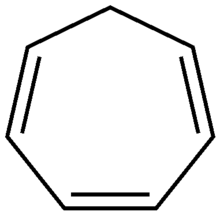Cycloheptatriene

| |
| Names | |
|---|---|
| Other names
CHT, 1,3,5-cycloheptatriene
| |
| Identifiers | |
3D model (JSmol)
|
|
| ECHA InfoCard | 100.008.061 |
CompTox Dashboard (EPA)
|
|
| |
| Properties | |
| C7H8 | |
| Molar mass | 92.141 g mol-1 |
| Melting point | -80 °C |
| Boiling point | 116 °C |
| Insoluble in water | |
Except where otherwise noted, data are given for materials in their standard state (at 25 °C [77 °F], 100 kPa).
| |
Cycloheptatriene or CHT is a colourless liquid that has been of recurring theoretical interest in organic chemistry. It is widely used as a ligand in organometallic chemistry and as a building block in organic synthesis.
Cycloheptatriene is not aromatic, and the ring is not planar, due to the presence of the -CH2- group. Removal of a hydride ion from the methylene group gives the planar and aromatic cycloheptatriene cation, also called the tropylium ion. A practical route to this cation employs PCl5 as the oxidant.[1]
Although Albert Ladenburg discovered cycloheptatriene in 1881 by the decomposition of tropine,[2][3] the structure was finally proven by the synthesis of Richard Willstätter in 1901. This synthesis started from cycloheptanone and proved therefore the seven membered ring structure of the compound.[4]
Cycloheptatriene can be obtained in the laboratory by photochemical reaction of benzene with diazomethane or the pyrolysis of the adduct of cyclohexene and dichlorocarbene.[5]
Another classic reaction for (a cycloheptatriene derivative) called the Buchner ring enlargement starts from reaction of benzene with ethyl diazoacetate to the corresponding norcaradiene carboxylic acid which at high temperatures rearranges with ring expansion to the cycloheptatriene carboxylic acid ethyl ester [6] [7].
Cyclooctatetraene and cycloheptatriene are used as a triplet quencher for rhodamine 6G dye lasers.[8][9]
See also
References
- ^ Conrow, K. (1973). "Tropylium Fluoroborate" (PDF). Organic Syntheses, Collected Volume 5,: 1138.
{{cite journal}}: CS1 maint: extra punctuation (link) - ^ A. Ladenburg (1883). "Die Constitution des Atropins". Justus Liebig's Annalen der Chemie. 217 (1): 74–149. doi:10.1002/jlac.18832170107.
- ^ A. Ladenburg (1881). "Die Zerlegung des Tropines". Berichte der Deutschen chemischen Gesellschaft. 14: 2126–2131. doi:10.1002/cber.188101402127.
- ^ R. Willstätter (1901). "Synthesen in der Tropingruppe. I. Synthese des Tropilidens". Justus Liebig's Annalen der Chemie. 317 (2): 204–265. doi:10.1002/jlac.19013170206.
- ^ H.E. Winberg (1959). "Synthesis of Cycloheptatriene". Journal of Organic Chemistry. 24 (2): 264–265. doi:10.1021/jo01084a635.
- ^ Buchner, et al., Ber., 18, 2377 (1885);
- ^ For a variation: Studies on the Polymethylbenzenes. IX. Addition of Ethyl Diazoacetate to Durene Lee Irvin Smith, Pliny O. Tawney J. Am. Chem. Soc.; 1934; 56(10); 2167-2169. doi:10.1021/ja01325a054
- ^ Tomi Nath Das, K. lndira Priyadarsini (1994). "Triplet of Cyclooctatetraene : Reactivity and Properties". Journal of Chemical Society Faraday Transaction. 90 (7): 963–968. doi:10.1039/ft9949000963.
- ^ R. Pappalardo, H. Samelson, and A. Lempicki (1970). "Long Pulse Laser Emission From Rhodamine 6G Using Cyclooctatetraene". Applied Physics Letters. 16 (7): 267–269. doi:10.1063/1.1653190.
{{cite journal}}: CS1 maint: multiple names: authors list (link)
